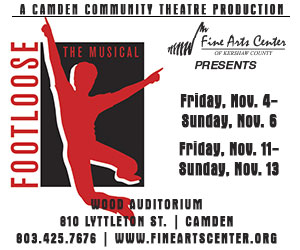Wearable Art
By Kristine Hartvigsen
With this article, Jasper introduces an occasional series on wearable art by Columbia-area artisans. This first in the series focuses on two local women who create hand-crafted art jewelry.
The stunning, straight-talking redhead who manages the Museum Shop at the Columbia Museum of Art, Bohumila Augustinova is perhaps best known around local art circles as the talented designer who won the Columbia Design League’s annual Runaway Runway recycled fashion show in 2009 with a wedding dress made of plastic shopping bags. But some of Augustinova’s most dazzling creations are much smaller in scale. These days, her exquisite, upscale jewelry pieces are coveted by the likes of local fine artists Anastasia Chernoff and Amanda Ladymon.
Augustinova’s jewelry technique can be traced to a centuries-old Moravian craft called “ticking,” whose origins actually were quite utilitarian. The artist says men in the mountain region of Slovakia, which borders Augustinova’s native Czech Republic, long ago used ticking to reinforce clay pots and other clay cookware against cracking and breaking. It was a craft of necessity, as families of modest means could not afford to constantly replace broken clay pots and would line up to have their pots reinforced with the wire ticking.
“What I have seen in pictures, some of those designs were incredibly beautiful,” Augustinova says, adding that she was introduced to the craft about 10 years ago on a whim while visiting her best friend in the Czech Republic, who happened to be operating a summer camp for youngsters. The camp offered arts and crafts classes, and Augustinova joined in.
“They were teaching us how to use the craft as a decoration for Easter eggs,” Augustinova explains. “They started showing us, and I picked it up. I immediately had so much fun doing it that it was an easy process to learn. It was second nature.” When she returned to Columbia, she immediately purchased wire-cutters, pliers, and related materials.
“I started with more decorative pieces, such as ornaments. Then, somehow – completely by accident – it became jewelry,” she says. “Someone would say, ‘that would look great as a necklace.'” And the inspiration took root.
The happy accident has made Augustinova’s jewelry a favorite among area women who value hand-crafted, one-of-a-kind statement pieces to wear to gallery openings, the ballet, and special events and galas. It’s all a bit of a mystery to Augustinova, who insists that her jewelry is much more of a leisurely hobby than a true artistic vocation. Amazingly, the artist suggests that her jewelry is perhaps the “least exciting” thing that she does, creatively speaking. Her larger wire works – including warrior-themed garments, masks, and even kites – have received accolades in the arts community, particularly after a First Thursday on Main show last summer at the Frame of Mind eyeglass boutique.
Bored with fabric, Augustinova says she relishes working with materials that are more challenging. “I like to change up what I do and play with big pieces,” she says. “I have designed costumes and clothes since I was 8 years old,” she says. Augustinova doesn’t own a sewing machine and will borrow one occasionally, but most of her fashions and costumes, including seductive wire dresses, require heavy-duty, hand-stitching that a machine cannot handle. “A wire dress takes about three months to make. A necklace may take about two hours. It’s like having a break or having a snack in the middle of the day. It’s more of a pastime.”
The artist says that inspiration for her designs is pretty random. She does not plan or sketch out anything but follows the energy of the piece as she works with it until “something clicks. Everything is in my head.”
Even though some renowned artists enlist and train apprentices to produce their work for a larger commercial market, Augustinova’s jewelry probably never will be produced in quantity by anyone else.
“I am too much of a control freak,” she says. “I tried that once. I was so unsatisfied with every detail. I can’t do that to anybody.”
For now, you can only find Augustinova’s jewelry at the Museum Shop, and she occasionally will indulge those wishing to place custom orders. “I have never made two of the same thing,” Augustinova says. “Every dress I make is different. Every mask I make is different. Every necklace I make is different. There may be similarities in style, but each piece is original.”
____
An act of vandalism at her high school unexpectedly opened up a fascinating new world for Caroline Hatchell. “Someone broke into my high school and smashed every trophy case in the school. There was glass everywhere,” Hatchell explains. “A friend of mine, whose family owned a jewelry store, she took the broken glass and made jewelry out of it,” selling the jewelry to raise money to help replace the school’s trophy cases.
“That was my first experience seeing someone take something and make a wearable piece of art with it,” Hatchell says. “I thought it was super cool.”
Hatchell already long had been intrigued with small things. An avid lover of the natural world, she would collect the tiniest wildflowers and spend hours creating diminutive flower arrangements. Collecting and assembling all sorts of small things in an artistic way held great interest for her.
“My dad was a house-builder. He had this nail apron that he would dump into a bucket every day,” Hatchell says. “One day, I emptied the entire bucket and sorted all the nails by size and type. Ever since then, I have had a fascination with anything small.”
After seeing the new possibilities that her high school friend had demonstrated by repurposing broken glass into art jewelry, Hatchell began to explore jewelry-making with all sorts of materials. She scoured the shelves of craft and thrift stores for interesting items, such as old buttons, toy parts, tiny tools, antique photos, ribbon, broken ceramic pieces, and beads, long before assemblage hobbies were popular and hobby stores stocked those kinds of materials for crafting. Ten to 20 years ago, finding unique items to use in “altered art,” mixed media, and studio jewelry was a sometimes-elusive treasure hunt that Hatchell relished.
“I eventually taught myself how to weave beads together,” Hatchell says. “I started with a regular sewing needle and thread. What I found out later on is that I (unknowingly) had taught myself how to do a peyote stitch. You weave the beads back and forth one bead at a time. That is where my whole fascination with beads in general came from. It was really fun, so I kept on doing it.”
Those explorations eventually led Hatchell to open her own business, The Bead Café in Lexington, which she owned and operated for six years before closing it to pursue a degree in environmental science at the University of South Carolina. Always curious and hungry for new knowledge, Hatchell still takes craft classes and workshops whenever she is able, indulging interests in mixed metals and even lampwork glass bead creation. All the different exposures have taken her jewelry to magical places.
“I really like mixed media,” she says. “Making something out of unusual objects is kind of where my jewelry path has led me − making something out of what’s available, found objects, and mixed media into wearable art.”
Hatchell’s jewelry got noticed and sold well. Soon she found herself writing “how-to” articles in craft publications such as Belle Armoire Jewelry and www.artitudezine.com. Many of her pieces incorporate elements inspired by nature, including birds, feathers, wings, flowers, and plants.
“I do not start with a set idea or plan,” Hatchell said in a 2009 interview in Belle Armoire. “I generally try to let ideas naturally unfurl. … I am just out there expressing myself. I try to make my jewelry distinctive, to give it its own voice. When people see my jewelry, they immediately know that I am not trying to sell just another product; I am offering my heart’s work.”
Hatchell’s favorite pieces these days are made from vintage photos, skeleton keys, and etched metals. She constructs them using “cold connections,” which involve joining metal pieces without soldering. Instead, she prefers to drill tiny holes and using metal rivets and wire to join pieces together. She says the metal adds dimension, and that the construction is really a form of layering the different materials.
Not surprisingly, Augustinova and Hatchell are friends and colleagues who have partnered in jewelry shows. Like Augustinova, Hatchell also has a connection with Runaway Runway. Hatchell’s dress crafted from pine straw, leaves, and flowers received rave reviews at last year’s event, though it did not win. In the past, Hatchell has sold her jewelry at the Museum Shop and at Portfolio Art Gallery in Five Points. She occasionally teaches workshops in jewelry-making, most recently at Swift Water Beads in Columbia. For now, however, Hatchell is taking a jewelry hiatus so she may concentrate on finishing that degree. But you can be sure this artist with a passion for making lovely statement jewelry with found objects will be back exhibiting new pieces before long.






.jpg)
